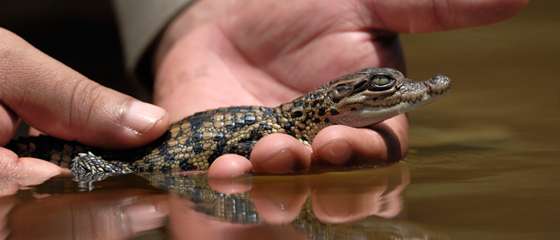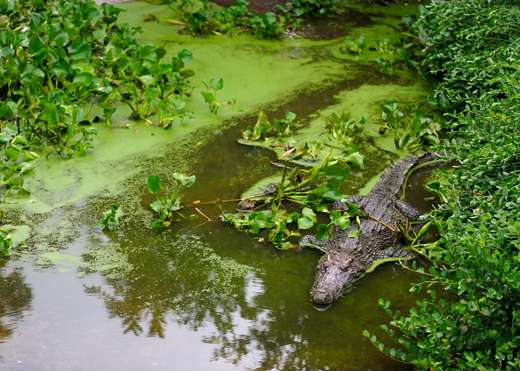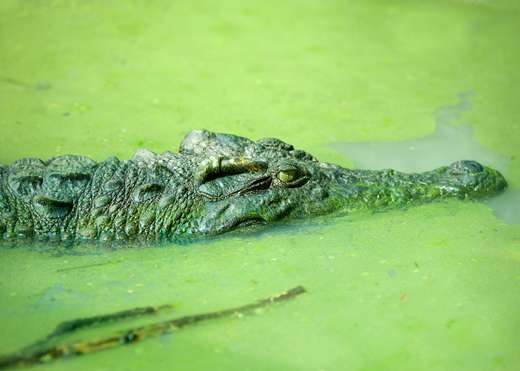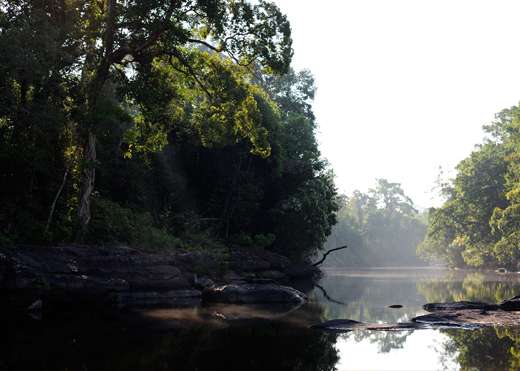A new paper 'Status, distribution and ecology of the Siamese crocodile Crocodylus siamensis in Cambodia' (October 2015, Cambodian Journal of Natural History) reports that fewer than 400 wild Siamese crocodiles remain in Cambodia, following decades of poaching. However, the paper concludes that there are good prospects of rebuilding their populations by enlisting the help of indigenous communities and by releasing genetically-screened captive-bred stock
The paper combines the findings and recommendations of Forestry Administration (FA), Fauna & Flora International (FFI), Fisheries Administration and Wildlife Conservation Society.
FFI contributed to this study through the Cambodian Crocodile Conservation Programme (CCCP), an award-winning joint programme with the Forestry Administration, which was established after Siamese crocodiles were rediscovered in Cambodia in 2000.
Lead author and CCCP manager Mr Sam Han said that after 15 years of dedicated research the findings for this Critically Endangered reptile were very robust.
"We have proved that the crocodile's numbers are so low that the species cannot recover without long-term help. A combined approach of on-the-ground conservation and population reinforcement is fundamental to the continued survival and recovery of this species," explained Mr Sam.
Between 2000 and 2014, many interviews and field surveys were conducted to document the species' distribution, ecology, status and threats.
Siamese crocodile. Credit: Jeremy Holden/FFI
Key findings include:
- Siamese crocodiles are present in 35 locations across 11 provinces, but many of these have only one or two isolated individuals.
- Nationwide, 224 individuals were counted, indicating that Cambodia still has the largest wild population of this species.
- The species mainly eats small prey, especially fish and snakes. There is no record of this species attacking humans in Cambodia.
- Ongoing threats to the crocodiles include poaching for crocodile farms, hydro-dam development, and accidental capture and killing using fishing gear.
- Siamese crocodiles have a slow reproduction rate, with fewer than five nests reported annually.
- Captive-bred crocodiles can help repopulate and reinforce the wild populations, but they must be genetically tested to avoid releasing hybrids.
- Good progress has been made in enlisting the cooperation of local communities to protect key wetlands.
Small and fragmented populations
Historical records indicate that Siamese crocodiles were once widespread throughout Southeast Asia, but they are now predominantly restricted to small water bodies in remote areas.
Siamese crocodile. Credit: Jeremy Holden/FFI
"Sadly, most sites with crocodiles contained evidence of only one or two individuals, with no juveniles or nests found to prove they were breeding," Mr Sam said.
Mr Sam estimates the national wild population to be approximately 200–400 individuals with only 100–200 mature adults.
"This means Cambodia's wild Siamese crocodile population falls far short of the several thousand individuals that most species require to be viable," he said.
Siamese crocodile habitat – Anglong Ta Chay, Cambodia. Credit: Jeremy Holden/FFI
"The release of genetically pure, captive-bred or head-started crocodiles is essential to help our wild populations recover, because few breeding adults remain and around 95% of eggs and new hatchlings are killed by flooding, disease and predation in the wild."
The role of crocodile guardians
FFI's Senior Conservation Biologist, Dr Jenny Daltry, said indigenous people have a critical role to play in protecting the crocodiles.
"In our surveys, over 75% of sites and 90% of individual crocodiles were found in south-west Cambodia, with the largest groups located near settlements of indigenous communities who traditionally revere crocodiles," Dr Daltry said.
"We hope that villagers in the Cardamom Mountains, who protect their local crocodiles, can be ambassadors for teaching and reassuring others that Siamese crocodiles are an asset and pose no danger when treated with respect.
"FFI and our Cambodian partners have made progress in reducing poaching and other dangers by forming groups of trained local wardens to monitor and patrol crocodile areas, providing appropriate livelihoods assistance and halting the use of high-risk fishing gear in crocodile breeding sites."
Journal information: Journal of Natural History
Provided by Fauna & Flora International



























